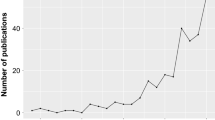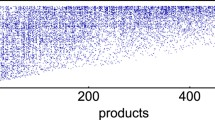Abstract
We use the exponential random graph models to understand the network structure and its generative process for the Japanese bipartite network of banks and firms. One of the well-known and simple models of the exponential random graph is the Bernoulli model which shows that the links in the bank–firm network are not independent from each other. Another popular exponential random graph model, the two-star model, indicates that the bank–firms are in a state where the macroscopic variables of the system can show large fluctuations. Moreover, the presence of high fluctuations reflects a fragile nature of the bank–firm network.





Similar content being viewed by others
Notes
x and \(x'\) are network states at simulation steps t and t+1, respectively.
References
Park, J., & Newman, M. E. (2004). Statistical mechanics of networks. Physical Review E, 70, 066117.
Barabási, A. L., & Albert, R. (1999). Emergence of scaling in random networks. Science, 286, 509–512.
Holland, P. W., & Leinhardt, S. (1981). An exponential family of probability distributions for directed graphs. Journal of the American Statistical Association, 76, 33–50.
Besag, J. (1974). Spatial interaction and the statistical analysis of lattice systems. Journal of the Royal Statistical Society. Series B (Methodological) 36(2),192–236.
Park, J., & Newman, M. E. (2004). Solution of the two-star model of a network. Physical Review E, 70, 066146.
Annibale, A., & Courtney, O. T. (2015). The two-star model: exact solution in the sparse regime and condensation transition. Journal of Physics A: Mathematical and Theoretical, 48, 365001.
Strauss, D. (1986). On a general class of models for interaction. SIAM Review, 28, 513–527.
Park, J., & Newman, M. (2005). Solution for the properties of a clustered network. Physical Review E, 72, 026136.
Lusher, D., Koskinen, J., & Robins, G. (2013). Exponential random graph models for social networks: Theory, methods, and applications. Cambridge: Cambridge University Press.
Wong, L. H. H., Gygax, A. F., & Wang, P. (2015). Board interlocking network and the design of executive compensation packages. Social Networks, 41, 85–100.
Simpson, S. L., Hayasaka, S., & Laurienti, P. J. (2011). Exponential random graph modeling for complex brain networks. PloS One, 6, e20039.
Hunter, D. R., Handcock, M. S., Butts, C. T., Goodreau, S. M., & Morris, M. (2008). ergm: A package to fit, simulate and diagnose exponential-family models for networks. Journal of statistical software, 24(3), nihpa54860.
Ripley, R.M., Snijders, T.A., & Preciado, P. (2011). Manual for siena version 4.0. Oxford: University of Oxford
Wang, P., Pattison, P., & Robins, G. (2013). Exponential random graph model specifications for bipartite networksa dependence hierarchy. Social Networks, 35, 211–222.
Hastings, W. K. (1970). Monte carlo sampling methods using markov chains and their applications. Biometrika, 57(1), 97–109.
Snijders, T. A. (2002). Markov chain monte carlo estimation of exponential random graph models. Journal of Social Structure, 3, 1–40.
Solomonoff, R., & Rapoport, A. (1951). Connectivity of random nets. The Bulletin of Mathematical Biophysics, 13, 107–117.
Erdos, P., & Rényi, A. (1960). On the evolution of random graphs. Publications of the Mathematical Institute of the Hungarian Academy of Sciences, 5, 17–60.
Coolen, A. C., Annibale, A., & Roberts, E. (2017). Generating random networks and graphs. Oxford: Oxford University Press.
Author information
Authors and Affiliations
Corresponding author
Additional information
This research was supported by MEXT as Exploratory Challenges on Post-K computer (Studies of Multi-level Spatiotemporal Simulation of Socioeconomic Phenomena, Macroeconomic Simulations). This research used computational resources of the K computer provided by the RIKEN Center for Computational Science through the HPCI System Research project (Project ID: hp180177).
Rights and permissions
About this article
Cite this article
Chakraborty, A., Krichene, H., Inoue, H. et al. Exponential random graph models for the Japanese bipartite network of banks and firms. J Comput Soc Sc 2, 3–13 (2019). https://doi.org/10.1007/s42001-019-00034-y
Received:
Accepted:
Published:
Issue Date:
DOI: https://doi.org/10.1007/s42001-019-00034-y




